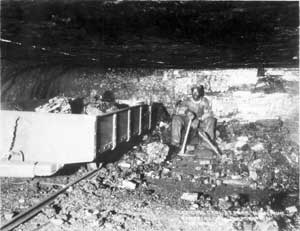|
 While lumbering
activity within The Stonycreek Corridor dates back to the
early 1800s, railroad access to the hillsides of virgin
hemlock and white pine prompted an eruption of logging
operations here by the start of the 20th century. A number
of loggers worked within the corridor. However none were
bigger or had a larger impact than the Babcock Lumber
Company. Babcock established a sawmill along the Roaring
Fork of Shade Creek that became Ashtola, an operations and
administration center. In the early 1900s, Babcock's
lumbering operation within The Stonycreek Corridor was one
of the largest in the state, producing 64 million
board-feet of lumber in 1905. Babcock ended operations
here in 1913 but continues lumbering operations elsewhere
to this day. While lumbering
activity within The Stonycreek Corridor dates back to the
early 1800s, railroad access to the hillsides of virgin
hemlock and white pine prompted an eruption of logging
operations here by the start of the 20th century. A number
of loggers worked within the corridor. However none were
bigger or had a larger impact than the Babcock Lumber
Company. Babcock established a sawmill along the Roaring
Fork of Shade Creek that became Ashtola, an operations and
administration center. In the early 1900s, Babcock's
lumbering operation within The Stonycreek Corridor was one
of the largest in the state, producing 64 million
board-feet of lumber in 1905. Babcock ended operations
here in 1913 but continues lumbering operations elsewhere
to this day.
There has been limited coal mining within the corridor
since the early 19th century. But in the final decade of
the 1800s, the railroads provided access to rich coal
reserves, which led to an explosion of activity. Within
the river basin are 14 coal beds of mine-able thickness.
Three of them - the Lower and Upper Kittanning, and Upper
Freeport seams - have been mined most extensively here.
The Berwind-White Coal Mining Company of Philadelphia
acquired 30,000 acres within the corridor in 1892-93 and
established its Eureka Coal mining operation. Over the
next couple of decades, Berwind established 13 mines and a
network of communities to support the operations. Windber
(whose name was created by switching the syllables in
"Berwind") was developed as a regional headquarters,
supporting company operations and providing regional
facilities for the individual mine (coal-patch)
communities. The company became the nation's largest
independent coal producer, and The Stonycreek's mines
accounted for 70 to 90 percent of the company's total
production between 1902 and 1916. Berwind mines remained
active within this region into the 1950s. Many other coal
operators also mined within The Stonycreek Corridor and
were responsible for the development of most of the
communities that exist here today. Surface mining began in
the 1940s and continues to produce significant tonnages of
coal there today.
Coal mining here started to decline after World War II,
and most operations had closed by the early 1980s. Today,
while limited coal mining continues within The Stonycreek
Corridor, it is just a vestige of the day when coal was
king here.
For
More History on Lumbering and Coal Mining click here
and go to page 27. (2.4mb)
Related Links:
|

